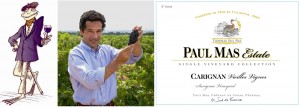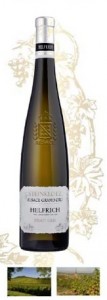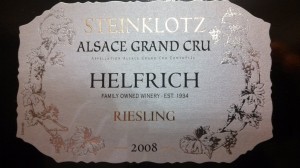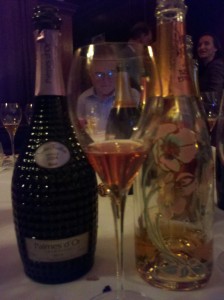
Having visited the southwest of France, I can attest that living in the Languedoc is lovely, but it’s certainly not London or Paris. Thus, it’s not surprising that members of the younger generation would want to leave the family farm and head to the big city. You might say that such folks are looking to swim in a bigger (read urban) pond.
In this tradition, Jean-Claude Mas pursued a career in the motor industry, living first in the United States and then in Paris, before entering the wine industry. But, Jean-Claude realized the potential of the Languedoc and the native son returned home to breathe new life into this bulk wine region. As the proprietor of Domaines Paul Mas, which includes the Arrogant Frog label, you might say that Jean-Claude is now the big frog swimming in this smaller (more rural) pond.
Although Jean-Claude never studied formally studied agriculture, he recognizes that there are five separate spheres of expertise required to craft world class wine – viticulture, winemaking, blending and aging, bottling and marketing –and makes sure to find the best people in each sphere and then hire them. What seems most interesting is the nearly equal value he places on all five spheres.
A true pioneer in an area where 70% of production is in the hands of co-ops, Jean-Claude shifted the focus away from quantity and instead turned his attention to quality. Moreover, he paid particular attention to what the market wanted. Arriving back in Languedoc in 1996, he saw tremendous worldwide interest in Australia and Chile and emulated, but didn’t imitate, those wines. In 2000, he took over the helm of Domaines Paul Mas, bringing his vision of producing premium wines to the family business.
Part of Jean-Claude’s pursuit led him to developing new ways of growing grapes in the area. He spent considerable time identifying the right terroir and now has eight different estates and produces four different levels of wine from his entry-level to his single estate wines. Beyond his own land, he contracts with 2,000 growers to source the fruit he needs. While he admits that there is a heavily reliance on old practices, Jean-Claude explains that “The growers will change when they know they’ll make money.”
And, while some frogs have noted that “it’s not easy being green,” Jean-Claude has been at the forefront of eco-friendly farming in the area. In this regard, Domaines Paul Mas has restricted its use to certified organic fertilizers and one of the estates, Les Tannes, is solely focused on the production of organically grown grapes. This same passion and commitment to the environment is brought to his contract growers, who are not only encouraged to adopt such practices, but are also provided with full technical advice.
Jean-Claude also places significant emphasis on creating balanced vines. He doesn’t use just one specific density in planting; rather, he is careful to match vine density with the fertility of the soil. Further, he looks to rootstocks and clones to achieve full ripeness.
For example, the ubiquitous Picpoul has not been highly regarded, but Jean-Claude didn’t fault the variety for its short-comings. Rather, he recognized that the grape is prone to chlorosis and countered this deficiency with better rootstocks and selected better clones. Once harvested, these grapes are fermented at temperatures similar to those used for Sauvignon Blanc and lees contact is included in the winemaking regimen. Consequently, in his words, his Picpoul is not a conventional one – combining the minerality of a Muscadet with tropical notes.
Likening wine style to food style, Jean-Claude acknowledges that a steak cooked rare can be the same quality as one cooked well done, but that it is a simply matter of style. Similarly, he believes that one needs to shape a wine based on one’s preferred style. He extends this analogy into the realm of fashion, speaking of blending and aging in the way that a fashion designer might choose to use silk or wool in his or her designs.
While Jean-Claude joked that, “The style of Languedoc is chaos,” his wines, particularly those from the Paul Mas Estate, were of a singular style – displaying complexity, balance and length. At suggested retail prices ranging from $14.00 to $25.00 (and likely available less expensively), these are wines that significantly over-deliver at this price point. Additionally, the attractive labels give them the appearance of more expensive brands, making them great for hostess gifts or hosting your own party.
Côté Mas St. Hilaire Crémant de Limoux Brut NV, SRP: $16.0
A blend of 60% Chardonnay, 20% Chenin Blanc, 10% Pinot Noir and 10% Mauzac, this sparkling wine offered some slight yeast, along with apple peel and citrus, on the nose and palate. It had a creamy mousse with high acidity and a long, but clean finish. Complex and elegant; stock up for holiday toasts and parties.
Paul Mas Estate Picpoul de Pinet 2011, SRP: $14.00
Wax, white flowers, honey and melon greet the nose. The dry palate has low to medium acidity and is relatively light-bodied, but the wine is rich in flavor – nectarine, honey, minerality, floral and melon persist throughout the long finish. Nicely balanced and a beautiful partner for grilled octopus (among many other dishes, of course).
Paul Mas Estate Carignan Vieilles Vignes 2010, SRP: $14.00
Black fruit dominates the nose and palate, accompanied by a meatiness and earthiness. With rich and concentrated fruit, a slate/mineral character is also present on the dry palate. Fresh fruit and minerality are the hallmarks of this complex wine.
Paul Mas Estate GSM 2010, SRP: $15.00
As its name implies, the GSM is a blend of 35% Grenache, 35% Syrah and 30% Mourvedre, all of which are typical grapes of the region as well as of nearby the Southern Rhone. Showing blueberry and blackberry aromas and flavors, this wine was fruitier than the others, but still decidedly dry. Ripe, silky tannins co-mingled with black and red fruit, and a hint of earth in the long length.
Chateau Paul Mas Clos de Savignanc 2010, SRP: $25.00
A blend of 30% Mourvedre, 40% Syrah and 30% Grenache, the make-up of this wine changes based upon the vintage. Black cherry, smoke, earth, herbal and mint, this wine displayed more secondary characteristics than primary ones. Full-bodied with good acidity, this wine will improve with some bottle age.
 the forest. After walking for awhile, she came upon a house. She knocked and, when no one answered, she walked right in.
the forest. After walking for awhile, she came upon a house. She knocked and, when no one answered, she walked right in.





